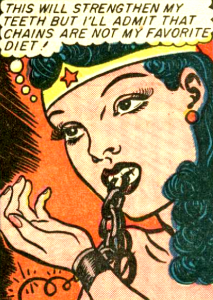 Wonder Woman: Bondage and Feminism
Wonder Woman: Bondage and Feminism
in the Marston/Peter Comics, 1941-1948
by Noah Berlatsky
Rutgers University Press
251 pages, $26.95
GREAT HERA, Wonder Woman lives! Noah Berlatsky, comic commentator and editor-blogger for the Hooded Utilitarian, takes the reader on an eye-opening exploration of the subtexts of the Wonder Woman comics from the series’ inception in 1941 to 1948. He focuses on the ideas of William Marston, Wonder Woman’s creator, and of Harry Peter, the series illustrator. Marston (1893-1947) was a psychologist, pulp novelist, and the inventor of a precursor to the lie detector. Harry Peter (1880-1958) was a newspaper illustrator who was an avid supporter of women’s equality.
Marston (also known as William Moulton Marston) held unconventional ideas about women, men, and relationships. He himself lived in a polyamorous relationship with two women, his wife Elizabeth Holloway and Olive Byrne, who continued to live with Elizabeth after Marston’s death in 1947. He had two children with each woman. Byrne was the niece of Margaret Sanger, the feminist and birth control crusader.
Berlatsky’s project involves analyzing and deconstructing the written and illustrated texts of the comics. In so doing, he brings out Marston’s underlying themes of submission, bondage, fetishism, kink, and lesbianism. Marston’s idea was to make a woman the strongest superhero of them all. He saw Wonder Woman as a distillation of the qualities that belonged to the so-called “new woman” of the 1920s—strong and independent, yet loving. He saw women as superior to men because they were motivated by love and kindness rather than by aggression and physical dominance, and he wanted men to be more like women.
Wonder Woman comics first appeared in 1941—the year that America entered World War II. Her costume was flag-inspired and visually served to imprint on young readers, girls and boys alike, her message of

patriotism. Her backstory was comic-book complicated, but the high points are these: Pilot Steve Trevor crash-lands on Paradise Island, home of Wonder Woman and the female Amazon Utopia. He tells the Amazons about the war and the fight for peace and freedom. Then, in a rather convoluted scenario, Wonder Woman—Princess Diana—takes on the persona of the all-too-human Diana Prince (reminiscent of Superman and his alter ego, Clark Kent) and returns with Steve to help fight the Axis powers, those enemies of democracy. As a superhero, she becomes a member of the Justice Society. Her weapons are the lasso of truth, her indestructible bracelets, a tiara that can be weaponized, an invisible airplane, Venus girdles of love, and a purple mind ray for healing—or, as she often says, “Thunderbolts of Jove!”
Berlatsky offers a thoroughly engaging discussion of Marston’s ideas and theories about gender and sexuality. He combs the verbal and visual texts to show how Marston and Peter conveyed their unique notions of liberation through bondage, submission, and the glorification of lesbian sexuality while simultaneously linking these ideas to feminism and freedom. This book is a bit heavy on queer theory and can be dense and abstract at times. However, the analysis is persuasive, and the subject matter fascinating.
Irene Javors, a psychotherapist and writer who lives in New York City, is the author of Culture Notes: Essays on Sane Living (2010). She is the proud owner of an original Wonder Woman watch!




